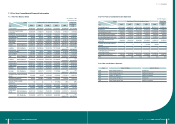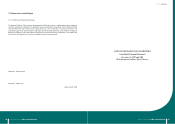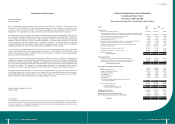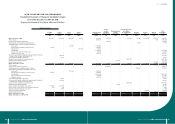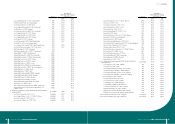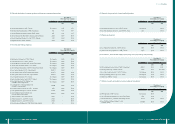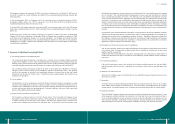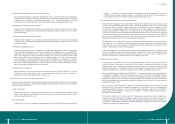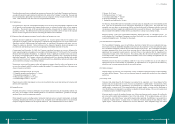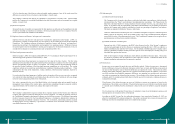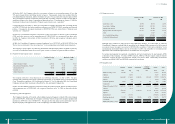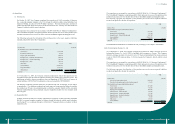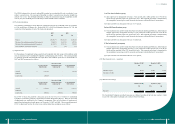Acer 2008 Annual Report Download - page 39
Download and view the complete annual report
Please find page 39 of the 2008 Acer annual report below. You can navigate through the pages in the report by either clicking on the pages listed below, or by using the keyword search tool below to find specific information within the annual report.
Acer Incorporated 2008 Annual Report74
Financial Standing
Acer Incorporated 2008 Annual Report 75
(a) Financial assets/liabilities at fair value through prot or loss
An instrument is classied as at fair value through prot or loss if it is held for trading or is designated as
such upon initial recognition. Derivatives that do not meet the criteria for hedge accounting are classied
as financial assets or liabilities at fair value through profit or loss. Financial instruments at fair value
through prot or loss are measured at fair value, and changes therein are recognized in prot or loss.
(b) Hedging derivative nancial assets / liabilities
Hedging derivative nancial assets / liabilities represent derivatives that are to hedge the risk of changes
in exchange rates resulting from operating activities denominated in foreign currency and meet the criteria
for hedge accounting.
(c) Hedging derivative nancial assets / liabilities
Hedging derivative nancial assets / liabilities represent derivatives that are to hedge the risk of changes
in exchange rates resulting from operating activities denominated in foreign currency and meet the criteria
for hedge accounting.
(d) Available-for-sale nancial assets
Available-for-sale nancial assets are measured at fair value and changes therein, other than impairment
losses and foreign exchange gains and losses on available-for-sale monetary items, are recognized in a
separate line item in stockholders’ equity. When an investment is derecognized, the cumulative unrealized
gain or loss recognized in equity is transferred to profit or loss. If there is objective evidence which
indicates that a nancial asset is impaired, a loss is recognized in prot or loss. If, in a subsequent period,
events or changes in circumstances indicate that the amount of impairment loss decreases, reversal of a
previously recognized impairment loss for equity securities is charged to equity; while for debt securities,
the reversal is allowed through prot or loss provided that the decrease is clearly attributable to an event
which occurred after the impairment loss was recognized.
(e) Financial assets carried at cost
Equity investments whose fair value cannot be reliably measured are carried at original cost. If there
is objective evidence which indicates that an equity investment is impaired, a loss is recognized. A
subsequent reversal of such impairment loss is not allowed.
(9) Derivative nancial instruments and hedging activities
Hedge accounting recognizes the offsetting effects on prot or loss of changes in the fair values of the hedging
instrument and the hedged item. If the designated hedging instruments meet the criteria for hedge accounting,
they are accounted for as follows:
(a) Fair value hedges
Changes in the fair value of a hedging instrument designated as a fair value hedge are recognized in prot
or loss. The hedged item is also stated at fair value in respect of the risk being hedged, with any gain or
loss being recognized in prot or loss.
(b) Cash ow hedges
Changes in the fair value of a hedging instrument designated as a cash ow hedge are recognized directly
in equity. If a hedge of a forecasted transaction subsequently results in the recognition of an asset or
a liability, then the amount recognized in equity is reclassied into prot or loss in the same period or
periods during which the asset acquired or liability assumed affects prot or loss.
(10) Noncurrent assets held for sale and discontinued operation
Noncurrent assets and groups of assets and liabilities which comprise disposal groups are classied as “held
for sale” when all of the following criteria are met: a decision has been made to sell, the assets are available
for immediate sale in their present condition subject only to terms that are usual and customary for sales
of such assets (or disposal groups), and their sale within one year is highly probable. Noncurrent assets or
disposal groups classied as “held for sale” are measured at the lower of their book value or fair value less
costs to sell. Noncurrent assets or disposal groups classied as held for sale are not depreciated, amortized
or depleted. Total assets and total liabilities are each shown separately and excluded from the individual
line items of the consolidated balance sheets. Interest and other expenses attributable to the liabilities of a
disposal group classied as held for sale shall continue to be recognized.
An impairment loss is recognized for any initial or subsequent write-down of the assets (or disposal groups)
to fair value less costs to sell in the consolidated statements of income. A gain from any subsequent increase
in fair value less costs to sell of an asset (or a disposal group) shall be recognized, but not in excess of the
cumulative impairment loss that has been recognized.
A discontinued operation is a component of an entity that either has been disposed of or is classied as held
for sale. A component of an entity comprises operations and cash ows that can be distinguished clearly,
both operationally and for financial reporting purposes, from the rest of the entity. A component that
previously was held for use will have been one or more cash-generating units.
(11) Equity method investments
Long-term equity investments in which the Consolidated Companies, directly or indirectly, own 20% or
more of the investee’s voting shares, or less than 20% of the investee’s voting shares but are able to exercise
signicant inuence over the investee’s operating and nancial policies, are accounted for using the equity
method. Prior to January 1, 2006, differences between the acquisition cost and net equity of the investee that
could not be attributed to any reason were amortized over ve years as investment income or losses.
The Consolidated Companies adopted amended SFAS No. 5 “Long-term Investments under Equity Method”
commencing from January 1, 2006. The investment cost in excess of fair values of identiable net assets
is recorded as investor-level goodwill. Investor-level goodwill is no longer amortized but tested for
impairment. Differences between investment cost and net equity of the investee in the previous investments
that cannot be attributed to any reason and were originally amortized over ve years are no longer amortized
starting from January 1, 2006.
When an equity-method investment is disposed of, the difference between the selling price and the
book value of the equity-method investment is recognized as disposal gain or loss in the accompanying
consolidated statements of income. If there are capital surplus and separate components of shareholders’
equity resulting from such equity investments, they are charged as a reduction to disposal gain/loss based on
the disposal ratio of investments.
If an investee company issues new shares and the Company does not acquire new shares in proportion to
its original ownership percentage, the Company’s equity in the investee’s net assets will be changed. The
change in the equity interest shall be used to adjust the capital surplus and long-term investment accounts. If
the Company’s capital surplus is insufcient to offset the adjustment to long-term investment, the difference
is charged as a reduction of retained earnings.


